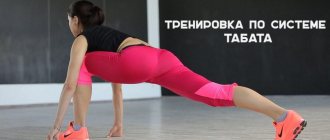If you have a very busy schedule and don't have time to go to the gym, interval training is what you need. Get 9 effective fat burning complexes and lose weight by doing just 5 minutes a day!
Author: Kristina Lobanovskaya, doctor, practicing nutritionist Article updated: 01/20/2021
Ask a Question
The frantic pace of life does not allow you to constantly visit the gym, but do you need to keep your body fit? This problem was easily dealt with by professional athletic trainers who came up with interval training methods.
Such programs were originally developed for athletes. During such intense exercise, a person urgently loses fat mass, builds muscle and increases endurance. Today, interval training has become widely used for weight loss.
Intense sessions are a series of high-impact exercises interspersed with short breaks or light exercise. The method works on the basis that such alternating rest allows you to “squeeze” the “maximum” out of the human body, which is impossible with normal physical activity.
Interval programs primarily help develop endurance. After just a few weeks of training, you will get rid of shortness of breath, and you will notice how easy it is to climb the stairs to the 10th floor. The training also improves the performance of the cardiovascular system. This factor is very important, since nowadays more than 35% of people die due to heart disease.
You will be pleased with the body's reaction to interval exercise: after just two weeks, the fat layer will begin to decrease, and the muscles will tighten and gain definition.
Training is not only useful, but also allows you to save time on sports. Examples of quick exercises include physical activity using the Tabata method, which lasts only 4-5 minutes. Effective exercises take very little time. The longest of them take half an hour.
How many calories can you burn doing interval training? Depending on the type of activity you choose, you can constantly get rid of 400 calories in half an hour; if you add dietary nutrition to physical activity, the results will increase.
Many women who visit gyms are interested in what interval training is as part of fitness. In fact, intense training is a type of fitness, but only with alternating levels of load.
It is recommended to conduct classes only twice a week, but between them it is advisable to insert regular loads in the pool, gym and others. This must be done, since interval exercises cannot replace calm and measured physical activity. Usually they are practiced for two to three weeks, after which they take a break for two months.
Programs and lesson plans are compiled depending on the level of training and skills of the athlete. Beginners are not advised to immediately take up interval training, since their body is not prepared and may not withstand intense loads.
To understand what interval training means, you must initially choose a suitable sport for yourself or choose your favorite exercise machine and try to work out. Such programs are used in athletics and weightlifting, fitness, running, skiing and other sports.
In any case, interval training is the best way to lose extra pounds and tone your muscles. This method of losing weight is recognized by many nutritionists and trainers, since with its help you can achieve an athletic body much more effectively.
Despite all the positive qualities of this weight loss method, there are some contraindications for its use:
- diseases of the heart and blood vessels;
- injuries;
- lack of experience in sports activities.
If you want to do interval training, you need to consult a doctor. Some people need to take a low-intensity course before the main physical activity, and only then increase the pace.
Why training works
The fast movements of a high-intensity workout push the body to its limits to achieve muscle fatigue and maximum oxygen consumption. It sounds complicated, but it's not.
The basic principle of operation: the more intense the muscles work, the more oxygen they require and the more calories are burned.
Oxygen levels are measured using VO2 max, which indicates the maximum amount of oxygen required during exercise.
Workouts that push your VO2 levels to the max trigger an afterburn mechanism that continues to consume oxygen and burns additional calories for up to 48 hours after exercise.
The best machines for HIIT
It is possible to perform this workout using a wide range of equipment, such as a stepper, stationary bike, or treadmill, but many find better results using sprints, whether on a treadmill or outdoors.
It has been proven that the closer you get to your maximum oxygen uptake (VO2max) during exercise, the more fat your body will use for energy afterwards. So, activity in which you can give it your all is your best tool for burning fat. If running is not an option, then sprinting on a bike or elliptical machine can serve as a good alternative.
Whatever machine or activity you choose, go hard, go fast, and leave a puddle of sweat. This shouldn't be easy!
Oxygen consumption and calorie burning
According to scientific research, it takes about five calories to consume 1 liter of oxygen.
As HIIT programs alternate between short bursts of intense exercise and moderate to low intensity exercise, researchers around the world are trying to figure out how to get more with less.
After extensive research into the effectiveness and efficiency of HIIT compared to monotonous workouts, it has been found that you can achieve comparable or greater results in less time using this method.
One study from the scientific journal Applied Physiology, Nutrition and Metabolism found that high-intensity interval training increases the metabolic activity of fats and carbohydrates in human skeletal muscle, without long sessions in the gym.
This means that the body successfully converts carbohydrates and fats into energy to fuel muscles. In simpler words, it is effective for fat burning.
The American authority on sports medicine, the American College of Sports Medicine (ACSM), states that HIIT provides the same fitness benefits as continuous aerobic endurance exercise, but in a shorter period of time.
They elaborated, commenting, "This is because high-intensity interval training tends to burn more calories, especially post-workout, than traditional long-term, steady-state exercise."
If there's one mystery or secret to HIIT, it's the calorie burn that comes with it.
Indeed, at this moment the full effectiveness and efficiency of this method is revealed.
By exercising intensely with minimal rest periods, you successfully kick-start your metabolism for several hours after your workout.
The professional term for this effect is EPOC or excess post-exercise oxygen consumption.
This means the body is working hard and it will take several hours and additional energy (calories!) for the body to return to its pre-workout state.
The exact amount of time your body burns calories at a higher level depends on the intensity and duration of the activity. Various studies have been conducted with a wide range of figures.
Some believe this occurs within 2 hours, while others have found that this effect can last for up to 48 hours after exercise.
Regardless of how many hours it actually lasts, this expenditure can add 6 to 15% more calories to your total energy expenditure.
For most women, the goal of exercise is to burn calories and lose weight/weight, but there are other benefits of HIIT.
According to the ACSM, HIIT affects:
- Aerobic and anaerobic fitness;
- Blood pressure;
- Cardiovascular diseases;
- Insulin sensitivity (which helps exercising muscles more readily use glucose as an energy source);
- Cholesterol levels;
- Abdominal fat and body weight while maintaining muscle mass.
IIT: precautions
Interval training for weight loss at home has many advantages, but there are also disadvantages. Working at this level of intensity is far from comfortable, especially if you are a beginner, and such a shock to the body, such as some plyometric exercises included in training programs, can lead to injury if the body is not ready for it.
Before you begin more advanced classes, you should go through at least a few weeks of preparation and make sure you do the following:
- Warm up thoroughly before you start exercising. This will help you prepare physically and mentally for training and protect you from injury.
- Watch the intensity. The point is to work at your best for certain periods of time. It’s quite normal to run out of energy, the intervals accumulate load, so that by the end the body simply requires oxygen. If you feel like it's too much for you, rest a little more. After some practice, you will know what load your body can handle.
- Skip exercises that cause you pain or discomfort. Also, feel free to substitute exercises if you feel that some of them are not suitable for you.
- Do no more than 1-2 IITs per week to avoid overtraining, injury or fatigue.
- Cool down after your workout and finish with some stretching.
How to Create Your Own HIIT Workout Plan
When designing a HIIT program, keep the following in mind:
- Lead time;
- Intensity;
- Recovery;
- The ratio of intensity and recovery process (low intensity);
- Frequency.
The ACSM, ACE, and NASM general recommendations for HIIT suggest the following:
| Duration | From 5 seconds to 2 minutes for women (for men up to 3 minutes) |
| Intensity | 80% to 95% of a person's maximum heart rate. |
| Recovery | 40% to 50% of a person's estimated maximum heart rate |
| Relationship between intensity and recovery period | From 1:1 to 1:3 |
| Periodicity | from 3 to 5 times a week |
A little more about intensity
When performing HIIT, the interval should be greater than or equal to your intended heart rate. A good subjective measure is the interval of work at which you seem to move from “difficult” to very “difficult.”
Using Joel Dowdell's "Talk Test" in his book "Ultimate You", you should find it challenging when moving to another level.
Another way to determine intensity is to use a point system.
According to ACE, intensity is measured on a scale of individual perceived exertion from 1 to 10. A level of 7 is considered high intensity.
A few words about low intensity and recovery
The intensity of recovery intervals should be 40%-50% of maximum heart rate. This is a physical activity during which a person feels comfortable and does not feel out of breath.
Think of your workout as an active holiday where you work on your body and take a break from putting in the effort.
Let's take a closer look at the ratio of high- and low-intensity efforts. The connection between work and recovery periods is important.
Keep in mind that the numbers will vary depending on the guidelines you follow during HIIT.
ACSM suggests a 1:1 ratio, while NASM suggests 1:2 to 1:3. (big number: recovery)
The Tabata protocol and Chris Jordan's seven-minute training are based on the inverse ratio: high-intensity periods are almost 2-3 times longer than recovery periods.
Let's focus on the ACSM 1:1 ratio and look at how it works:
Example:
- A 1:1 ratio of 3 minutes of hard training (or high intensity training) followed by 3 minutes of rest (or low intensity training).
- Workouts with a 1:1 ratio often last around 3, 4 or 5 minutes with a similar recovery period.
This combination of exercises can be repeated 3 to 5 times.
During sprint intervals, higher intensity efforts typically last for a shorter amount of time (20-30 seconds).
Combining the above exercise principles will help you maximize fat loss and build muscle in significantly shorter workouts.
Since time is of the essence for most women, good time management is a valuable feature of HIIT.
A little more about frequency
ACSM suggests exercising 3-5 times per week, with each session lasting less than 60 minutes.
Cons of Interval Cardio
At the same time, experts have also identified the negative impact of interval loads. Their disadvantages:
- Not recommended for beginners due to the high intensity of the load. Such loads are difficult even for experienced athletes, let alone those who have just started training. You need to start small, and only after a while you can try to introduce interval cardio into the program. For those who suffer from obesity or joint diseases, such activities are generally contraindicated.
- It is important to properly combine exercises with strength training so as not to overstrain your muscles and joints. For example, if you work on your legs 2 workouts a week and plan to add interval training after the main load, the risk of joint injury increases.
- Frequent interval training is dangerous. Even if you notice that your body is changing every day, and you are ready to give it your all every day, remember: interval cardio training should be performed no more than twice a week. Often in gyms there are people who, after standard strength training, decide to finish off their body with an hour-long interval session - this should never be done.
- Difficulty of execution. If habitual cardio allows you to relax and even enjoy the process, then with interval it’s the opposite. Training is most often accompanied by unpleasant sensations, burning and nagging pain in the muscles. This is a normal process. If an athlete is not ready to give 100% and gives up after the first heavy load, interval cardio is not for him.
To avoid injuries, the main thing is to choose the exercise option that will be optimal for the body. Gradually the athlete will be able to adjust it in favor of increasing intensity. The ideal training scheme can only be achieved through trial and error.
The Science Behind High-Intensity Interval Training
HIIT uses both aerobic and anaerobic training, while regular cardiovascular exercise has exclusively aerobic benefits.
Aerobic exercise requires oxygen to produce energy in the form of ATP or adenosine triphosphate, whereas anaerobic exercise does not.
High-intensity interval training affects muscle tissue at the cellular level, actually changing mitochondrial activity in the muscles themselves.
Possibility of maintaining muscle mass
If a person frequently engages in classical cardio exercises, he gradually loses overall muscle mass. The reason is that immediately after the end of energy glycogen, which provides energy, whole protein from the muscles will begin to be used. This phenomenon is not observed during interval training.
Sufficiently intense cardio is ideal not only for those losing weight, but also for those who are completely focused on obtaining muscle mass that is useful for building a figure.
Be sure to read: Meditation as an effective tool for losing weight
Examples of High Intensity Interval Training
Different interval training protocols vary greatly in duration, intensity, ratio of high to low intensity, and intensity level.
Among the hundreds of HIIT protocols available, there are 3 that are particularly well known and widely used.
Three HIIT protocols:
- Tabata method;
- Little-Gibal method;
- Turbulent training.
Tabata Protocol
Tabata protocol training was developed in 1996 in Japan by Dr. Izumi Tabata and his colleagues.
His method is based on a 2:1 ratio and involves high-intensity circuits at 170% of VO2 max and lasts 4 minutes, including all rest periods.
With Tabata, you perform a total of 8 sets of 20 seconds of high-intensity exercise followed by 10 seconds of rest.
Tabata training is recommended to be performed 2 to 4 times a week.
This HIIT protocol is best suited for those who are already in good shape and looking for activities that require little time to complete.
Although the original Tabata method used sprinting, it can also be done through strength training.
Tabata Protocol:
- 3 minutes warm-up;
- 20 seconds sprint;
- 10 seconds rest (walking);
- Repeat the sprinting cycle a total of eight times.
Little-Gibal method
Dr. Jonathan Little and Martin Gibala developed the Little-Gibala Method in 2009. This method involves high-intensity training at 95% of VO2 max.
The protocol provides for 60 seconds of high-intensity work, 75 seconds of low-intensity work, 8-12 circles should be completed.
Western Oregon University published a study on HIIT from the Gatorade Sports Science Institute. According to this study, people who trained 3 times a week using this method obtained results similar to what would be expected from people who trained at the same pace (50-70% VO2max) five days a week.
Approximate training plan using the Little-Gibal method:
- Warm-up - 3 minutes;
- Cycling - 60 seconds, fast with maximum resistance (at 95% of VO2 max);
- Bicycle - 75 seconds of slow riding at low resistance;
- repeat 8-12 cycles.
Repeat the fast/slow cycle for a total of 27 minutes.
The Little-Gibal method is best suited for people of intermediate fitness who have at least 30 minutes to work out and can save three days a week.
Turbulent method
Master's student in exercise physiology Craig Ballantyne developed the turbulence method. It consists of eight repetitions of “strength training” interspersed with one to two minutes of cardio.
The training protocol is alternating high-intensity and low-intensity strength training with high-intensity cardio loads.
It is recommended to do strength training in combination with cardio three times a week.
How to do turbulent training?
- Warm-up – 5 minutes;
- 8 repetitions of a set of strength exercises (for example, squats with dumbbells);
- Burpee or mountain climber – 1 min;
- Repeat the procedures for 45 minutes maximum.
Turbulence training is best suited for people who have a lot of time to train and want to incorporate strength training into HIIT.
Where to begin
One of the benefits of HIIT is that people can exercise anywhere, including at home or in a park. People can use their exercise routines for intervals between exercises. They can ride a bike, sprint, or use a jump rope. People can also perform various exercises using only their body weight, such as:
- press swing
- push-ups
- jumping
- squats
Example of a 25-minute workout
5-minute warm-up
15-Minute HIIT Circuit:
- intense exercise for 15 seconds
- rest 10 seconds
- intense exercise for 15 seconds
- rest 20 seconds
- intense exercise for 15 seconds
- rest 30 seconds
- intense exercise for 15 seconds
- rest 40 seconds
- intense exercise for 15 seconds
- rest 50 seconds
Repeat this circle three more times
5 minute stretch to cool down
People can either stop exercising during rest periods or switch to light exercise such as walking or cycling.
Is HIIT right for you?
Although effective, HIIT is not for everyone.
Undoubtedly, it is very effective and can be combined with cardio and strength training. Remember that the program is quite intense and demanding on the body.
If you do not have experience with HIIT, then it is better to gradually introduce them into your classes.
Even for people with a reasonable level of fitness and experience in HIIT, it is always recommended to gradually increase the difficulty for safety and to prevent injury.
Training programs
HIIT beginner workouts for women
We've created a HIIT plan for women who want to start working out to use as a guide.
Perform all exercises in a circle. Follow the technique of their implementation. Rest for a minute between sets. Do 10-12 repetitions of each exercise for 3 sets.
Read and follow the exercise instructions.
1. Squats.
- Stand straight, feet shoulder-width apart;
- Bend your knees and lower your hips as far as possible. Stay in this position for 1-2 seconds and return to the starting position.
- Repeat the exercise the recommended number of times before moving on to the next exercise.
2. Jumping Jack.
- Feet together, arms at your sides;
- Jump with your feet shoulder-width apart and your arms above your head;
- Immediately return to the starting position.
3. Push-ups.
- Take a lying position, your palms are strictly under your shoulders;
- The body forms a straight line from head to toe. Keep your back straight, bend your elbows and lower your chest as low as possible to the floor. Stay in this position for 1-2 seconds, then return to the starting position.
- Do 10-15 reps.
4. Reverse lunges.
- Starting position: feet shoulder-width apart, hands on hips.
- Take a big step back with your right foot. Lower until your right knee almost touches the floor.
- Return to the starting position: lean on your left leg and return your right leg back. This is one approach.
- Do 10-15 repetitions, then switch legs.
5. Reverse push-ups.
- Sit on a bench, chair, or step that is stable enough to support your body weight. Hands are shoulder-width apart, fingers pointing forward, elbows slightly bent and “looking” back.
- Extend your legs in front of you with your knees slightly bent.
- Slowly lower your body until your shoulder joints are below your elbows. Rise until your elbows are almost straight. Don't touch your elbows.
6. Plank.
- Starting position: take a lying position, lean on your forearms and toes, your body forms a straight line.
- Tighten your abs and buttocks as hard as possible and hold in this position for 30-60 seconds.











